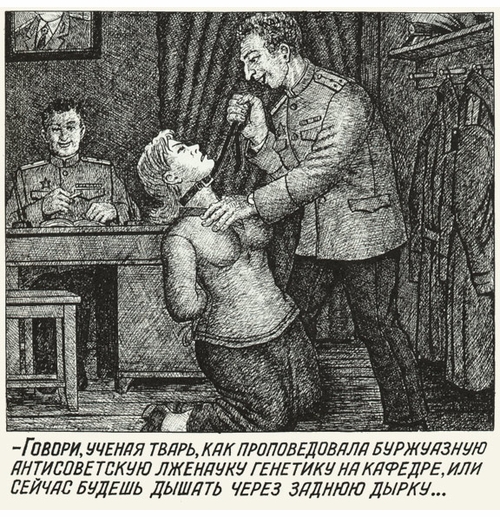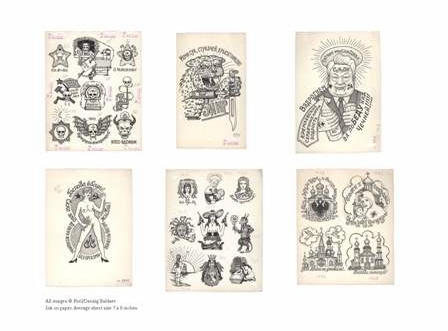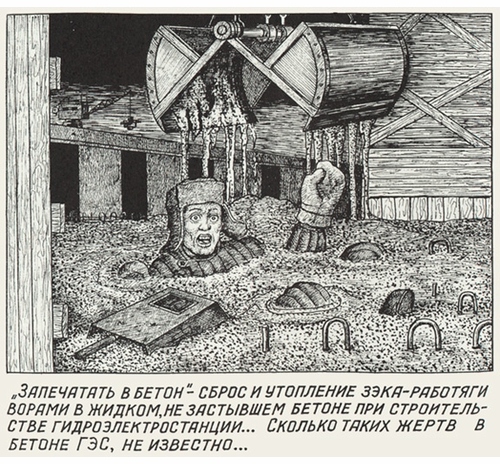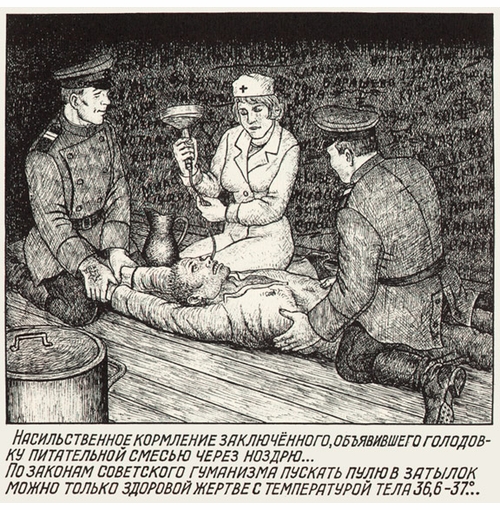| RECENT POSTS DATE 12/5/2024 DATE 11/21/2024 DATE 11/16/2024 DATE 11/13/2024 DATE 11/11/2024 DATE 11/9/2024 DATE 11/7/2024 DATE 11/6/2024 DATE 11/6/2024 DATE 11/5/2024 DATE 11/3/2024 DATE 11/2/2024 DATE 11/1/2024
| | | JANE BROWN | DATE 10/4/2010D.A.P. Vice President and National Accounts Director Jane Brown queries Damon Murray & Stephen Sorrell, publishers of Fuel, on their new book of drawings by the late Danzig Baldaev, a Russian prison guard who made unique chronicles of the infamous gulags.
Caption to drawing above: "Tell me now, you educated animal, about how you preached genetics, that bourgeois anti-Soviet ersatz science, in your university department, or you'll be breathing through your arsehole!"
______________________________________________
JB: Is there a Baldaev archive? If so, is the archive in Russia? Who discovered the archive? How did Fuel get access to all of these drawings - the tattoo drawings and these gulag drawings?
FUEL: The archive is actually with us. Danzig Baldaev died in 2005 leaving his drawings to his wife. In 2002 a friend of ours who knew of his work showed us some of the tattoo drawings and we knew immediately they would make a fascinating book. From this we put together the first Russian Criminal Tattoo Encyclopaedia. Following the success of this book we traveled to St. Petersburg and met with his widow, who kept all the drawings in bin bags and boxes secreted around her tiny flat. We made a further edit and gathered enough material for the next two volumes. Unfortunately a number of the original drawings had been lost over the years and Mrs Baldaev was concerned about the rest. We were keen the show the originals to a wider audience so she allowed us to buy all the remaining original tattoo drawings (around 600 sheets, some with just a single image, some with up to 10 or 12). We are currently looking for suitable gallery space, both in the UK and the US in which to exhibit this amazing collection.Above: A selection Russian criminal tattoos
During our last visit she showed us the images that make up the Drawings from the Gulag book (unfortunately most were copies, the originals had been lost). We saw the potential to make a book about the Gulag system, told from the perspective of a guard, someone who is inside that system and is privy to its workings, as far as we are aware there are no other visual books telling this history from this perspective. Our aim was also to bring knowledge of this terrible suffering to a wider audience. Because of the success of Danzig's tattoo books we knew there would be an interest in this subject from anyone who owned them. This book forms the perfect accompaniment to that series, explaining the extreme conditions in which the Russian criminal was able to thrive. Mrs Baldaev also gave us a number of files containing Danzig's notes and essays on the system itself including: Forms of Humiliation, Torture and Murder; Terms Used to Describe Prisoners; an interview with an 'authoritative' thief comparing Communist Party and Criminal Power Structures. These documents have been translated and are published here for the first time.
JB: Clearly Baldaev had to keep the Gulag drawings separate and secretive—how did he do that? In other words, how did he keep his gulag drawings from the Russian authorities?
FUEL: Because Danzig Baldaev is now dead the only details we have about this are from his widow. We know that his tattoo drawings had been reported to the KGB, and that surprisingly they had supported him in his work, realizing the value of being able to tell the history and status of a criminal from the images on his body. So we can establish that he had the 'trust' of the authorities. It is also important to remember that (despite his obvious hatred of the actions of the authorities which is clear from his depictions and their commentaries), he was also one of them - working for the NKVD - so he was an insider. His widow informed us that he was only able to make quick sketches and brief notes about the tattoos (and the Gulag) while he was at work, as he still had to fulfill his job as a guard. He would then take these roughs home to his flat, where he would work on them in great detail using pen and ink, often late into the night. We can assume that these drawings were made alongside his 'officially sanctioned' works and kept hidden in his flat until the end of the Communist era.Caption to image above: "Sealing in concrete.' A worker prisoner is drowned in liquid concrete by criminal inmates during the construction of a hydroelectric power plant. There is now way of knowing how many victims the concrete structures of power plants hold."
JB: Baldaev didn't start working as a prison guard until 1948, how did he create the depictions of the Gulag prior to '48 (from 1917 to 1947)?
FUEL: Obviously no one could be present at all the events shown in this book. Baldaev's widow has explained how around a fifth of the drawings are from first-hand experience. The rest of the images are the result of the artist's meticulous research. Some of this history would have been common knowledge, but as a guard in the biggest prison in Leningrad (Kresty - 'the Crosses'), he was able to speak with other guards and prisoners to establish an accurate history. A significant number of the tattoos in the RCTE series date from before 1948; Baldaev would have spoken with all the owners of these tattoos, asking them their meanings as well as other details. It's clear (from the documents reproduced in Drawings from the Gulag too), that he must have been able to converse in an amicable way and gather information from both sides of the wire.Caption to image above: "Force-feeding a prisoner on a hunger strike with a nutrient solution through the nostril. According to the most 'humane' Soviet laws, only a healthful individual with a body temperature of 36.6 – 37 degrees Celsius could be shot in the head."
JB: Was his original intention to create a chronology of the history of the prison labor camps, or did he randomly document sequences it the history of the gulag?
FUEL: This is difficult to answer. He might have started with a clear chronology, but as the book progresses it concentrates on elements of the system that he was obviously interested in and outraged by: the methods of torture of suspects before they were sent to the Gulag; the power of the criminals within the Gulag; etc.
JB: Have these gulag images been published in Russia? If so, what was the reaction there?
FUEL: No, not as far as we are aware. To date (ie, before publication) the Russian response to this work has been an interesting one. It is still a delicate subject; these events are not as well known as they should be. Perhaps that has something to do with survival – which in its own way carries a particular sense of guilt. Generally people seemed to have focused on the more disturbing scenes and reacted with disbelief. When we were putting the book together we were determined to establish the drawings as 'fact' by adding footnotes taken from the considerable amount of historical documentation. We felt that because they were drawings they were too easily dismissed as figments of the author's imagination or simply misinformation. We did a lot of research, mainly using first-hand accounts from survivors' memoirs, to establish the drawings as accurate representations of techniques, events and atrocities.  FUEL Publishing
Hbk, 6.5 x 8 in. / 240 pgs / 30 b&w.
| |
|




